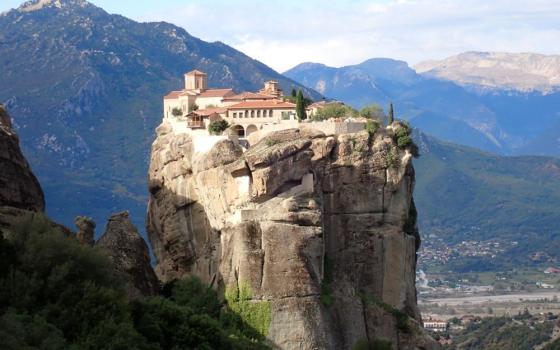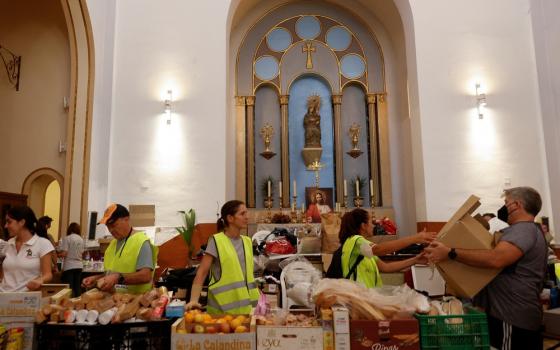I was only 8 months old on the day the Second Vatican Council was opened. I have no personal memories of the event itself. Yet, in a very real way, my adult life has been spent within the bosom of that Council. Those texts and, yes, the spirit of the Council shaped the Church in which I try and make my way through life in profound ways. I believe that both the texts and the spirit of the Council point in the same direction, the person of Christ, in ways that the Church is still realizing, or at least, ways that I am still realizing.
The debates about the proper hermeneutic for understanding the Council are important, to be sure, but one thing, and one thing only, should guide us: Christ is the measure. Christ whom the Church has always proclaimed as “the same yesterday, today and forever.” Christ whom we can find anew when we come face to face with the poor. Christ who feeds us in the sacrament of the altar and who forgives our sins in the sacrament of penance. Christ who unites man and woman in marriage. Christ who passes on the apostolic authority from generation to generation through the endowment of His Spirit and the laying on of hands. Christ who stands at the bedside of the dying to see them across the abyss. Every criticism I have to offer of what I would consider an improper understanding of the Council arises out of this concern: Is Christ the measure or is nostalgia for a past that is as imagined as it is unrecoverable? Is Christ the measure or is some extraneous agenda drawn from the ambient culture? Do we start our intellectual and spiritual wanderings with Him, or do we start elsewhere?
To say that some saw Vatican II as a complete rupture from what went before is too obvious to require much commentary. How did this happen? In part, Vatican II was the first Council at which the press was a major player, reporting on the events in real time. Xavier Rynne’s “Letters” in the New Yorker set the stage and, like all journalists, Rynne was attuned to change. It is not news when the train arrives on time, only when the train crashes. Some saw Blessed Pope John XXIII’s call to discern the signs of the times as a warrant to adopt the signs of the times, forgetting that discernment is not wholesale acceptance, certainly not uncritical acceptance, especially when the ambient culture is, to put it charitably, in some degree of flux.
The danger with the “Brave New Church” interpretation of the Council should be obvious by now: It has taken the decrees of the Council and treated them like play-dough, able to be molded as anyone sees fit. In the 1968 movie “The Shoes of the Fisherman,” a cardinal brings the findings of a doctrinal investigation to the newly elected Pope. The investigation concerned his close friend, a young priest, and so, when the cardinal says that the priest’s work cannot be published, the Pope, played by Anthony Quinn replies, “Did not the Second Vatican Council affirm the rights of conscience in the clearest terms?” Of course, it did. But, it affirmed the rights of conscience in juridical terms regarding the state, it did not say that there was no authoritative understanding of the faith within the Church. There, in 1968, in the popular mind, it was already evident that this teaching on conscience was confused. Sadly, it is still confused.
Let us look to another often mistaken conciliar idea, the “People of God.” When the Council first began considering the Constitution on the Church, it began with a draft written by the Vatican curia. The draft was widely criticized by the Council fathers. They did not criticize the draft because its theology was wrong. Instead, they argued that the theology was insufficient, that the text expressed a view of the Church that was too juridical and insufficiently theological. The revised text did not begin with the idea of the Church as the People of God, but, instead, with the theological idea of the Church as Mystery and Sacrament. But, we Americans are a practical people and “mystery” is a bit amorphous. Besides, the phrase “People of God,” when heard by American ears, sounds a lot like “We the People.” It turns out, of course, that the phrase was scarcely used to describe the early Church by the Fathers. It was rooted in the experience of the Jewish people. It was, for them, a statement of ownership: They did not belong to Pharaoh, they belong to the God of Israel. Even a vague familiarity with the Hebrew Scriptures would show the back-and-forth of salvation history and caution against any idea that the People of God was somehow sovereign. Indeed, the irony of the post-conciliar understanding of the phrase “People of God” is found precisely here: The phrase was introduced to provide a richer theological and less juridical view of the Church, but after the Council, many on the left reduced the idea to a juridical concept and wondered where the ballot boxes were!
The Constitution on the Liturgy was the first text the Council Fathers took up. Here, the points of continuity are completely obvious: Pope Pius X’s effort to increase the frequency of communion, Pope Pius XII’s restoration of the Easter Vigil, and of course the liturgical renewal begun at Solesmes. Indeed, just before the Council opened, Pope John XXIII made an extraordinary intervention: Without consultation, without dialogue, he inserted St. Joseph into the Roman Canon. This sent a very mixed message. On the one hand, it was an authoritarian act. On the other, it demonstrated that the text of the Roman Canon could be amended. Then, when the Council Fathers gathered, they were exposed to the rich variety of rites: Most bishops knew only the Roman rite, not the Ambrosian or the Eastern rites. But, these rites were not spontaneous. They were not improvised. They were ancient. I have witnessed my share of improvisation at the altar. Until I am guaranteed that every priest has the felicity of expression of Shakespeare, I think they should stick to the text.
Nostra Aetate was a truly seminal text, opening the way for interreligious dialogue in ways that had been unimaginable previously. In the 1890s, Cardinal Gibbons had been chastised for his willingness to participate in a “Parliament of Religions” associated with a World’s Fair. The fear of indifferentism was unmatched before Vatican II by a fear of isolation. It became obvious to the Council Fathers that a sense of exclusivity (and worse!) had actually distorted our tradition. And, so, for centuries, Christians had repeated the absurd charge of deicide against the Jews, citing the Ur-text of anti-Semitism from the Gospel of Matthew: Let his blood be upon us and upon our children! Finally, at the Council, after a lot of intellectual spadework, the Fathers recognized what is so obvious, it should make us all blush: We want the blood of Jesus on us and on our children. That is the blood that saves. But, for centuries, this soteriological fact had been lost in the pit of anti-Semitic prejudice.
Gaudium et Spes is the document most of us left-of-center Catholics cut our teeth on. Some of it still reads powerfully even though some of it is undoubtedly dated, shaped by an optimism of the time that might have benefited from an Augustinian edit. Nonetheless, it powerfully restates Catholic social teaching, developed by several popes up until that time, and stamps those teachings with conciliar authority. But, even here, we find that the measure of Catholic social teaching is not efficacy, not even justice. The measure is Christ:
The truth is that only in the mystery of the incarnate Word does the mystery of man take on light. For Adam, the first man, was a figure of Him Who was to come, namely Christ the Lord. Christ, the final Adam, by the revelation of the mystery of the Father and His love, fully reveals man to man himself and makes his supreme calling clear. It is not surprising, then, that in Him all the aforementioned truths find their root and attain their crown.
I have cited this text many times. It was the conciliar text most frequently cited by Pope John Paul II in his many encyclicals. We Catholics who take our commitment to social justice seriously, who tend the garden of those teachings, must take care of the root, we must never forget it. We are not social workers, we are Catholics. We care for the poor not only because it is ethically good to do so, but because we are commanded by the Lord Jesus to do so. Indeed, not just commanded, but we discover in the self-revelation of Jesus what it means to be humane. The commitment to social justice is not rooted in ethics, it is rooted here, in Gaudium et Spes #22, in the “revelation of the mystery of the Father and His love.” Those who claim to be “prophetic” but whose positions end up remarkably close to the editorial positions found at the New York Times, need to re-think what it means to be prophetic and what it means to be faithful to the Council.
I have been critical here of those on the left. But if the filter of modernity can distort, so too can the filter of nostalgia. When I see a photo of Cardinal Burke in his cappa magna, I think – really? If the left sometimes goes astray, the right sometimes makes itself ridiculous. Something real and important happened at Vatican II, and while I support entirely Benedict’s call for a hermeneutic that recognizes continuity as well as discontinuity, the Church today has been blessed beyond measure by the fruits of the Council. The cappa magna does not suggest “servant Church” to me or to anyone. Nor does fidelity to Christ exhaust its claims on the human person by issuing in a kind of sexual puritanism. The call to renewal that speaks from every page of the texts of Vatican II is a real call and we are all still learning just how radical the idea of renewal in Christ is.
An ecumenical council is a great event in the life of the Church. Vatican II was no exception. It is normative in a way few other events in the life of the Church are normative. Like all such councils, the years that follow are times of exploration and application, there are mistakes and corrections, there is a long process of discernment. But at its heart, Vatican II did not call us Catholics to ape the times in which we live, nor did it call us to wish ourselves back to the 1950s. Vatican II called us – and calls us still - to discern the ways the self-revelation of the Father’s love in the person of Jesus Christ tells us all we need to know about ourselves, about our world, and about our Church. Vatican II called us to engage the world, to be sure, but we are to engage the world with the self-same proclamation that has been the Church’s ultimate claim to relevance and significance and truth since that first Easter morning: The tomb is empty. If some on the left have become chaplains to the status quo and some on the right have become chaplains to the 1950s, the Council calls us to be chaplains at the empty tomb. There – and only there – do we find what our hearts are yearning for. There – and only there – do we find the heart of the Second Vatican Council.




